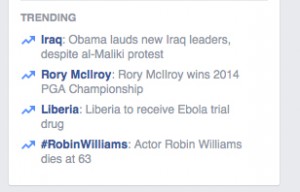Network Literacy: Virility vs Validity
In this weeks symposium related to Network Literacy the question of how we judge the validity of online content was thrown to the panel.
 Among the responses Jason raised the idea that the number of people saying something online, specifically using the example news of Robin Williams death spreading on Facebook, can help to determine, to some degree, the level of validity of a piece of information. There is obviously some credibility in information that is more widely accepted and shared than communally rejected, though I think a point Jason may have failed to articulate in this is how heavily dependent on the quality of the source or the platform this kind of validation is, a point that Betty raised and I’d like to explore as it holds it’s own questions of how to identify a trustworthy source.
Among the responses Jason raised the idea that the number of people saying something online, specifically using the example news of Robin Williams death spreading on Facebook, can help to determine, to some degree, the level of validity of a piece of information. There is obviously some credibility in information that is more widely accepted and shared than communally rejected, though I think a point Jason may have failed to articulate in this is how heavily dependent on the quality of the source or the platform this kind of validation is, a point that Betty raised and I’d like to explore as it holds it’s own questions of how to identify a trustworthy source.

As Elliot touched on there are certain indicators that create an image of validity to a source, say for example a news outlet (any source deemed to be valid will exhibit traits that are encoded to indicate this validity), the existence of such cues though allows for them to be identified, mimicked and emulated, exploited to spread erroneous information or to create effective satire and parody (see: Onion News). There are whole sites dedicated to featuring the best viral hoax of the day and others generally trying to create such viral content (ClickHole – a parody of BuzzFeed/Upworthy. Both emerging “news” platforms that are somewhat minefields of their own with advertiser generated content – perhaps a topic for a later blog). Some of these hoaxes quite expertly employ tactics to appear valid, be that a well executed Photoshop application, the deployment of design conventions from websites of other sources that have authority to be taken for granted as valid (others attempts can be seen a mile away with a basic literacy, though some have been adopted by legitimate platforms muddying this water – this is nothing new or internet specific though check out number 6 on this list)
The idea that we only use 10% of our brain capacity is false, but it was for a long time circulated widely and often taken to be truth, the myth still permeates pop culture today with an upcoming blockbuster movie based on the premise. Of course validity can also be restricted by knowledge of the time, a point perhaps irrelevant to network literacy, but let’s not forget that at one point in time everyone was saying the earth was flat or that the sun revolved around it. That only few people asserted something contrary at various times supported the idea these people were, well, mad. 3 million people sharing a story about Facebook planning to introduce fees on accounts or 50 people on Yahoo! answers telling you that toothpaste will remove acne is probably not cause to sign off on the validity of those claims.

This leads to the point of fact checking, and identifying credible sources – quality not always quantity. Betty mentioned a number of institutions which are given a level of authority on the legitimacy of their information, due to our expectations and perceptions of their function and role, determining that they are required to provide accurate information. It all boils down to judgement, authority and transparency really. The more transparent the source the easier to judge the validity of it’s content, the more authority we give a source the more likely we are to trust it. Of course a credible source can provide invalid information, unintentionally (as in providing what is commonly accepted as fact despite new evidence to the contrary) or intentionally (in the case of propaganda, which Betty and Adrian touched on occurring more in less developed nations, but also in corporate media — also social media seems to drive the creation of a lot of rhetorical and reductive political material in the form of ‘informative memes’ from political parties all over – accuracy often compromised for impact) the ability to identify the motivations for this misinformation (which are often hidden) and to cross-check against other sources are pivotal literacies in determining validity in any communication.
My Doctor told me I should vaccinate my child, but then someone much louder than my Doctor told me not to:
http://www.clickhole.com/blogpost/my-doctor-told-me-i-should-vaccinate-my-children-t-653



